It looks like you're using an Ad Blocker.
Please white-list or disable AboveTopSecret.com in your ad-blocking tool.
Thank you.
Some features of ATS will be disabled while you continue to use an ad-blocker.
share:
First I give you information about the main city of the planet. I mean of course Zelenograd.
Zelenograd means "green city."
March 3, 1958 is considered the date of foundation of Zelenograd.
Zelenograd is located on the territory of the Moscow region, about 40 kilometers from Moscow.
However, the inhabitants of Zelenograd from the very beginning had the status of Muscovites.
Zelenograd is the first and only satellite city of Moscow and its exclave surrounded on all sides by the Moscow region.
250 thousand people live in Zelenograd.
Zelenograd was built next to the village of Kryukovo (which was later included in it).
This village at the end of 1941 was the arena of battles between the troops of the USSR and the German troops rushing to Moscow.
At this line, the Germans were stopped and thrown back from Moscow.
Zelenograd was built as a city of Soviet microelectronics. It had many relevant factories.
The status of the city of Zelenograd as an administrative district of Moscow is fixed in the law of the city of Moscow on July 5, 1995.
So now there is a paradoxical situation: some state structures consider it as a city, and other structures, for example, the Russian statistics agency, consider it as a district of Moscow.
So this is the emblem of the city of Zelenograd.
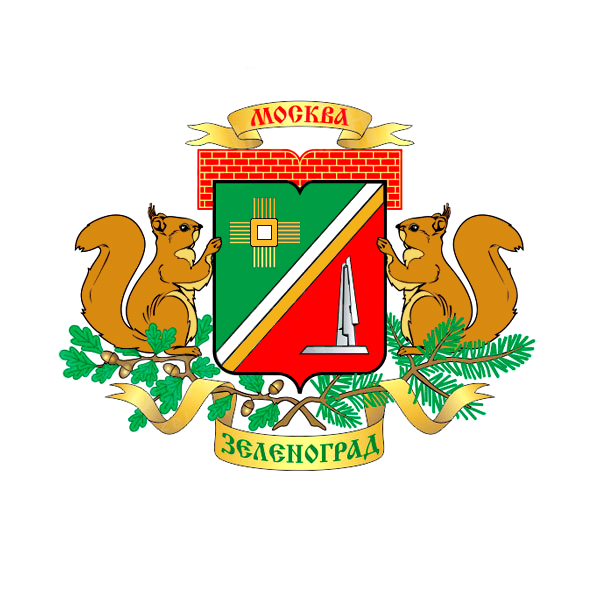
In the shield of the Moscow form there is a left narrow band, beveled with silver and gold. In the upper green background is a gold and silver stylized microchip in the form of a straight equilateral cross. In the lower red background is a silver monument to the defenders of Moscow. The shield is superimposed with its upper part on the red, walled with gold, figured battlement of the wall of the Moscow Kremlin. Above the prong is a gold ribbon with the inscription in red letters: "MOSCOW". The shield is held by two squirrels of natural colors, sitting on two crossed branches of natural colors - oak on the left and spruce on the right. The branches are intertwined with a gold ribbon with an inscription in green letters - "ZELENOGRAD".
The left narrow band, bevelled with silver and gold, symbolizes the two largest federal highways passing through the territory of Zelenograd - the railway line and the highway connecting Moscow and St. Petersburg.
A gold and silver stylized microchip in the form of a straight equilateral cross on a green background symbolizes the leading role of Zelenograd in the formation and development of the domestic microelectronic industry.
The silver monument to the defenders of Moscow on a red background symbolizes an important line of defense of the capital, the beginning of the defeat of the Nazi troops in the battle of Moscow in 1941.
Two crossed branches of natural colors, oak and spruce, symbolize the vast deciduous and coniferous forests surrounding the city and directly included in the architectural and planning structure of Zelenograd.
Two squirrels of natural colors symbolize the love of Zelenograd residents for the nature of their district and especially for these most popular animals in the city, which children and adults watch every day and feed from their hands.
Zelenograd means "green city."
March 3, 1958 is considered the date of foundation of Zelenograd.
Zelenograd is located on the territory of the Moscow region, about 40 kilometers from Moscow.
However, the inhabitants of Zelenograd from the very beginning had the status of Muscovites.
Zelenograd is the first and only satellite city of Moscow and its exclave surrounded on all sides by the Moscow region.
250 thousand people live in Zelenograd.
Zelenograd was built next to the village of Kryukovo (which was later included in it).
This village at the end of 1941 was the arena of battles between the troops of the USSR and the German troops rushing to Moscow.
At this line, the Germans were stopped and thrown back from Moscow.
Zelenograd was built as a city of Soviet microelectronics. It had many relevant factories.
The status of the city of Zelenograd as an administrative district of Moscow is fixed in the law of the city of Moscow on July 5, 1995.
So now there is a paradoxical situation: some state structures consider it as a city, and other structures, for example, the Russian statistics agency, consider it as a district of Moscow.
So this is the emblem of the city of Zelenograd.

In the shield of the Moscow form there is a left narrow band, beveled with silver and gold. In the upper green background is a gold and silver stylized microchip in the form of a straight equilateral cross. In the lower red background is a silver monument to the defenders of Moscow. The shield is superimposed with its upper part on the red, walled with gold, figured battlement of the wall of the Moscow Kremlin. Above the prong is a gold ribbon with the inscription in red letters: "MOSCOW". The shield is held by two squirrels of natural colors, sitting on two crossed branches of natural colors - oak on the left and spruce on the right. The branches are intertwined with a gold ribbon with an inscription in green letters - "ZELENOGRAD".
The left narrow band, bevelled with silver and gold, symbolizes the two largest federal highways passing through the territory of Zelenograd - the railway line and the highway connecting Moscow and St. Petersburg.
A gold and silver stylized microchip in the form of a straight equilateral cross on a green background symbolizes the leading role of Zelenograd in the formation and development of the domestic microelectronic industry.
The silver monument to the defenders of Moscow on a red background symbolizes an important line of defense of the capital, the beginning of the defeat of the Nazi troops in the battle of Moscow in 1941.
Two crossed branches of natural colors, oak and spruce, symbolize the vast deciduous and coniferous forests surrounding the city and directly included in the architectural and planning structure of Zelenograd.
Two squirrels of natural colors symbolize the love of Zelenograd residents for the nature of their district and especially for these most popular animals in the city, which children and adults watch every day and feed from their hands.
a reply to: turretless
OK. Looks like a computer monitor to me which would be a cool symbol in micro-electronics.
The squirrels are very nerdy ... which you find a lot of in micro-electronics.
P
The silver monument to the defenders of Moscow on a red background symbolizes an important line of defense of the capital, the beginning of the defeat of the Nazi troops in the battle of Moscow in 1941.
OK. Looks like a computer monitor to me which would be a cool symbol in micro-electronics.
The squirrels are very nerdy ... which you find a lot of in micro-electronics.
P
originally posted by: pheonix358
OK. Looks like a computer monitor to me which would be a cool symbol in micro-electronics.
The squirrels are very nerdy ... which you find a lot of in micro-electronics.
In reality it looks like this.
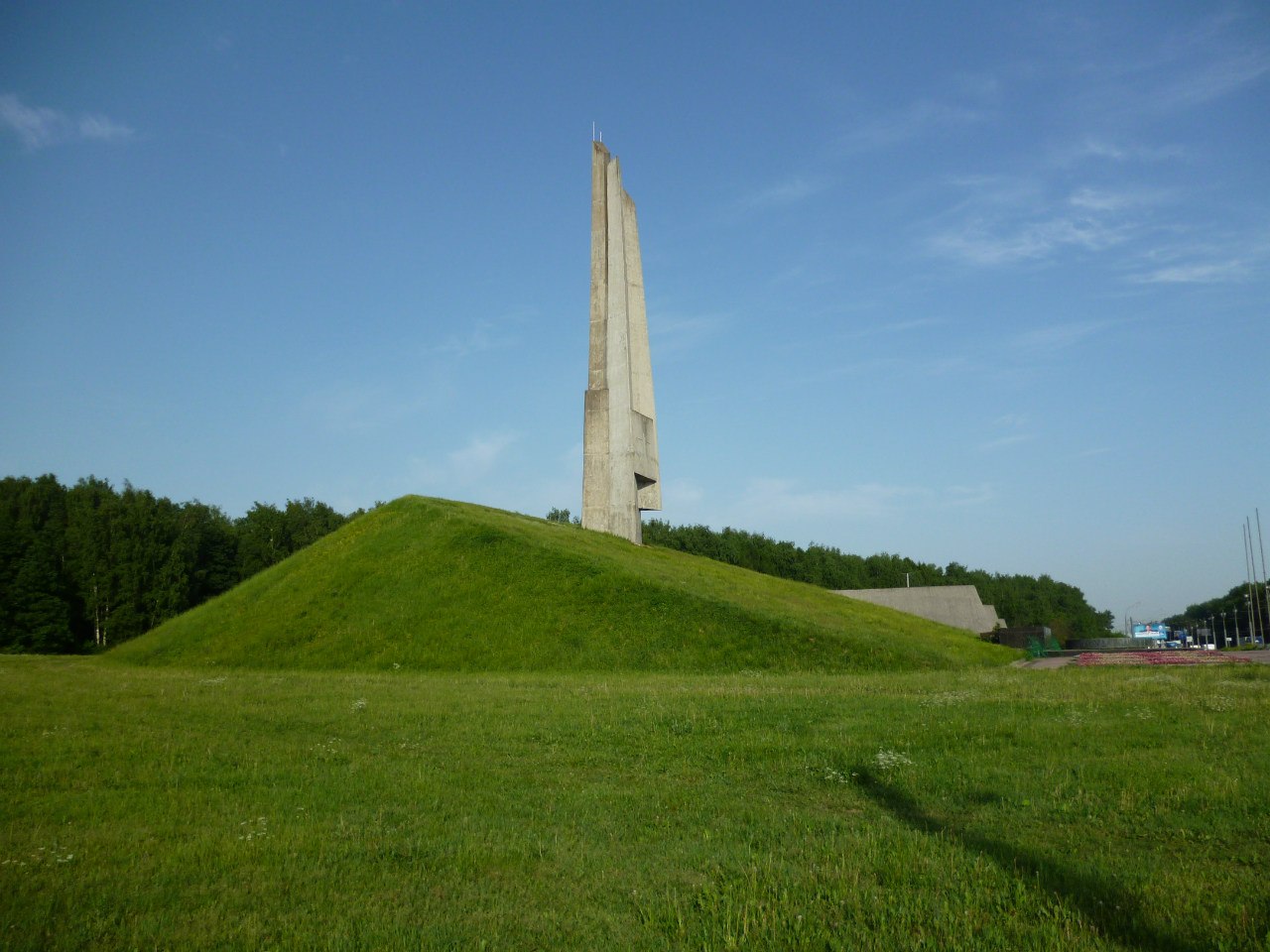
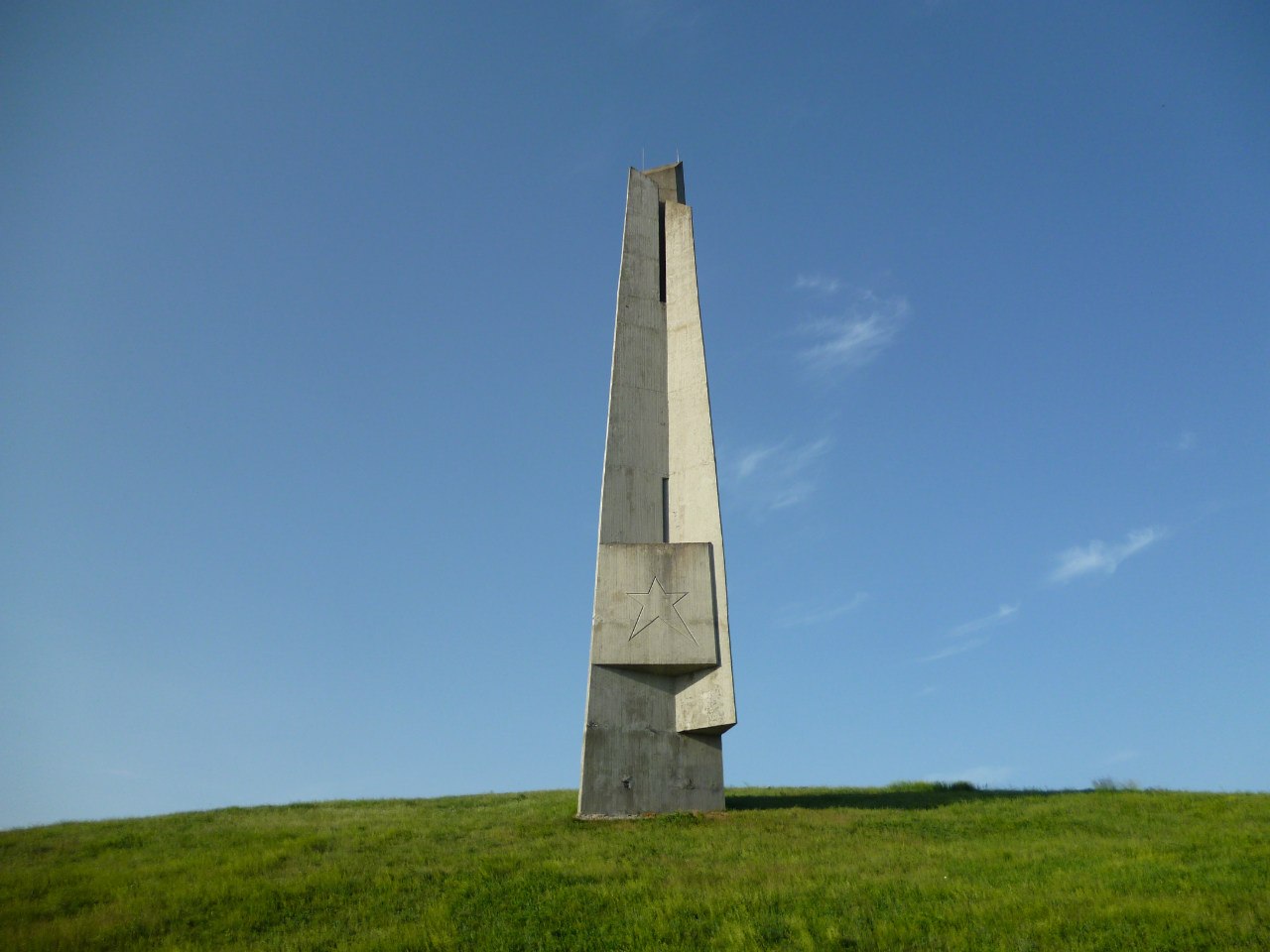
You concentrate mainly on microelectronics.
But in my opinion, four aspects are expressed in the emblem of the city:
1) close connection between Zelenograd and Moscow;
2) the heroic fighting past of this place;
3) microelectronics;
4) forests around and on the territory of Zelenograd.
Very apt symbology. Interesting satellite city.
First time I have seen squirrels used as a symbol apart from road signs.
P
First time I have seen squirrels used as a symbol apart from road signs.
P
Emblem of the Russian Federation.
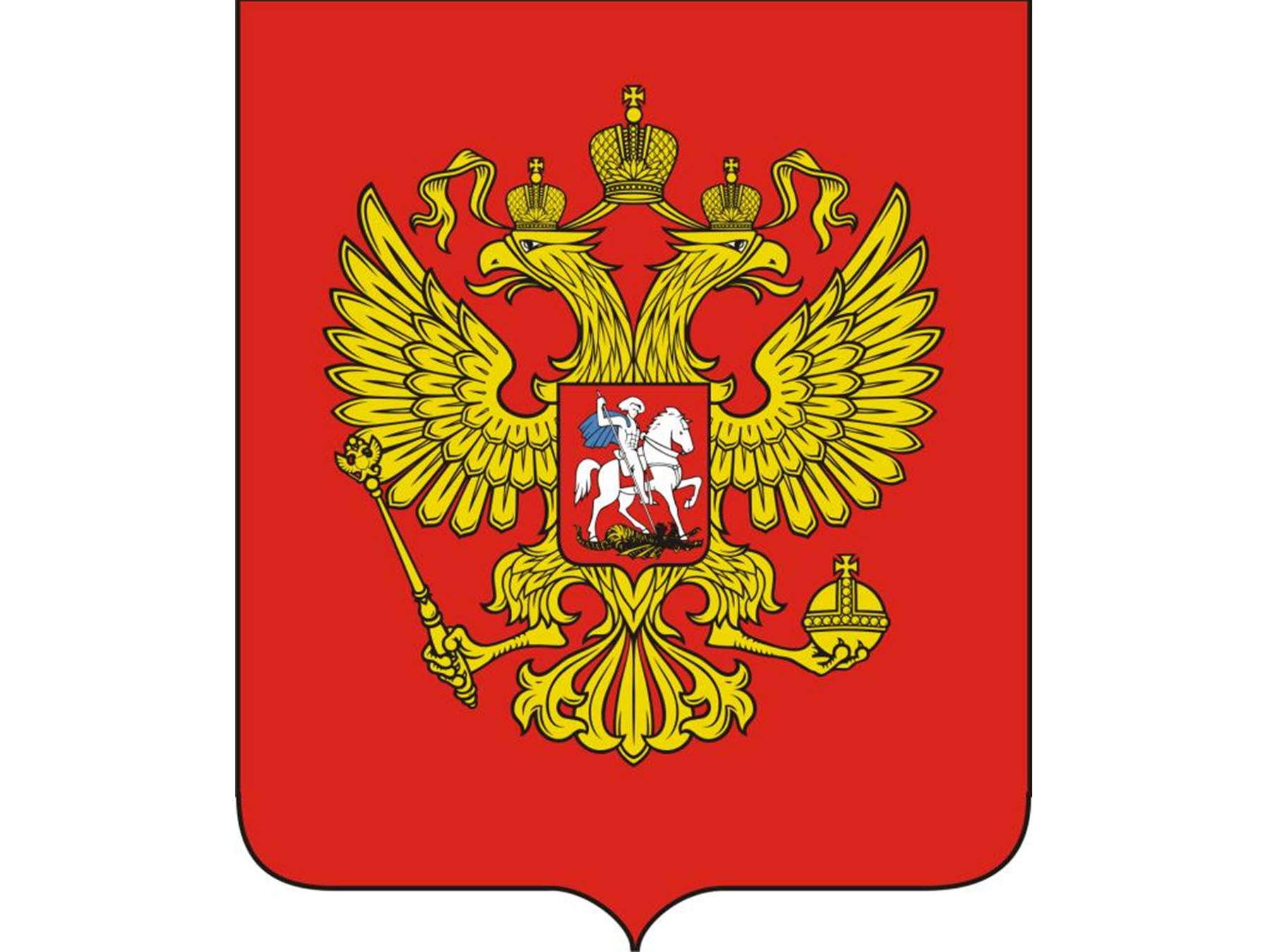
The State Emblem of the Russian Federation is a quadrangular, with rounded lower corners, pointed at the tip, a red heraldic shield with a golden double-headed eagle that raised its spread wings. The eagle is surmounted by two small crowns and above them by one large crown connected by a ribbon. In the right paw of the eagle is a scepter, in the left paw is an orb. On the chest of the eagle, in a red shield, there is a silver horseman in a blue cloak on a silver horse, striking with a silver spear a black dragon overturned and trampled on his horse.
The emblem of the Russian Federation is based on the historical emblem of the Russian Empire. The golden double-headed eagle on a red background preserves the historical continuity in the colors of the emblems of the late 15th-17th centuries. The drawing of the eagle goes back to the images on the monuments of the era of Peter the Great. Three historical crowns of Peter the Great are depicted above the heads of the eagle, symbolizing in the new conditions the sovereignty of both the entire Russian Federation and its parts, subjects of the Federation; in the paws there is a scepter and an orb, personifying state power and the unity of the state; on the chest there is an image of a horseman slaying a dragon with a spear. This is one of the ancient symbols of the struggle between good and evil, light and darkness, the defense of the Fatherland. The restoration of the double-headed eagle as the State Emblem of Russia embodies the indissolubility and continuity of Russian history. Today's emblem of Russia is a new emblem, but its components are deeply traditional; it expresses different stages of national history and continues them in the third millennium.

The State Emblem of the Russian Federation is a quadrangular, with rounded lower corners, pointed at the tip, a red heraldic shield with a golden double-headed eagle that raised its spread wings. The eagle is surmounted by two small crowns and above them by one large crown connected by a ribbon. In the right paw of the eagle is a scepter, in the left paw is an orb. On the chest of the eagle, in a red shield, there is a silver horseman in a blue cloak on a silver horse, striking with a silver spear a black dragon overturned and trampled on his horse.
The emblem of the Russian Federation is based on the historical emblem of the Russian Empire. The golden double-headed eagle on a red background preserves the historical continuity in the colors of the emblems of the late 15th-17th centuries. The drawing of the eagle goes back to the images on the monuments of the era of Peter the Great. Three historical crowns of Peter the Great are depicted above the heads of the eagle, symbolizing in the new conditions the sovereignty of both the entire Russian Federation and its parts, subjects of the Federation; in the paws there is a scepter and an orb, personifying state power and the unity of the state; on the chest there is an image of a horseman slaying a dragon with a spear. This is one of the ancient symbols of the struggle between good and evil, light and darkness, the defense of the Fatherland. The restoration of the double-headed eagle as the State Emblem of Russia embodies the indissolubility and continuity of Russian history. Today's emblem of Russia is a new emblem, but its components are deeply traditional; it expresses different stages of national history and continues them in the third millennium.
originally posted by: pheonix358
Very apt symbology. Interesting satellite city.
First time I have seen squirrels used as a symbol apart from road signs.
Thank you.
I also don't know other emblems where there is a squirrel.
Emblem of the USSR.
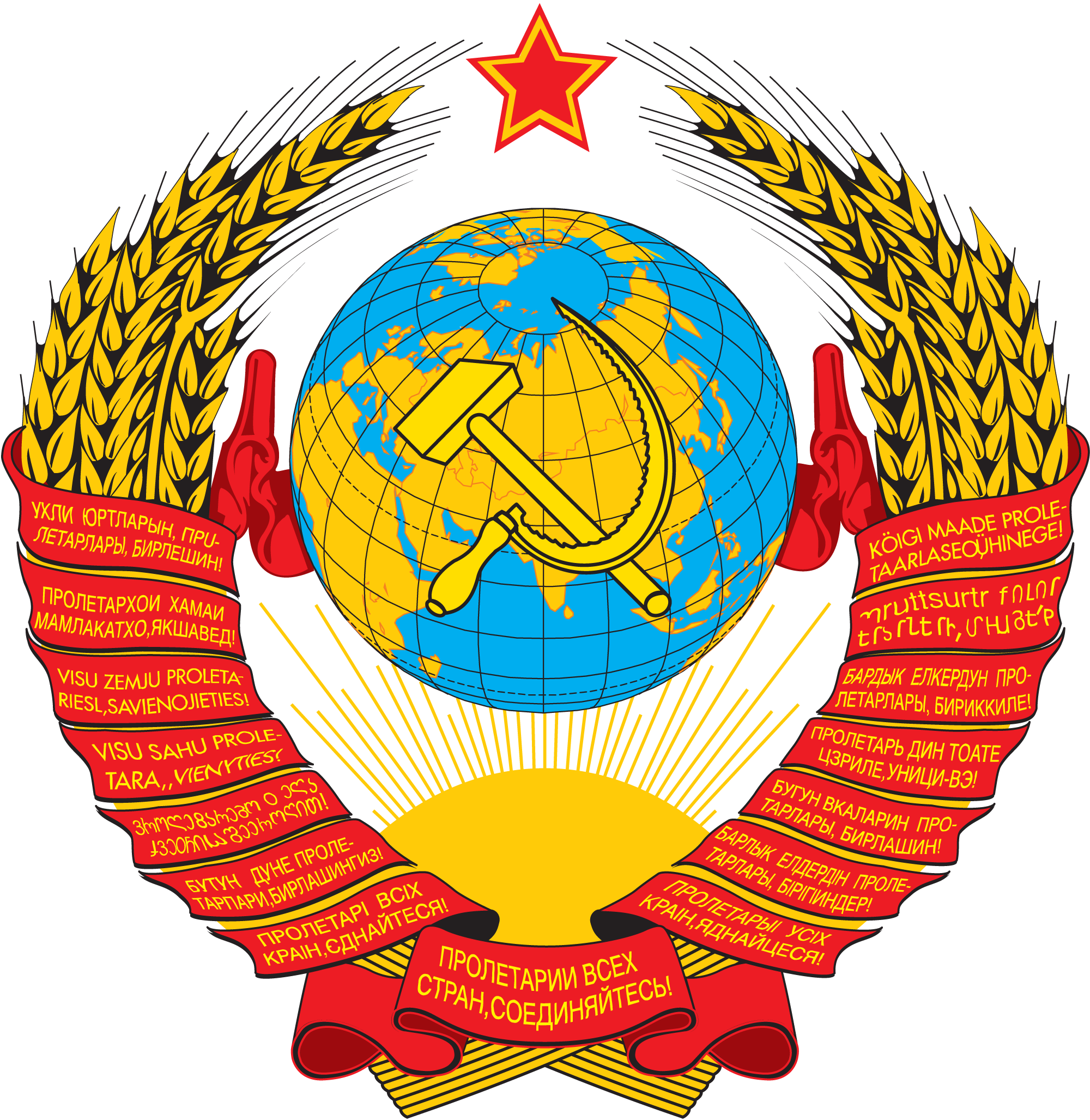
The state emblem of the Union of Soviet Socialist Republics is an image of a sickle and a hammer against the background of the globe, in the rays of the sun and framed by ears of corn, with an inscription in the languages of the union republics: "Proletarians of all countries, unite!" There is a five-pointed star at the top of emblem.
The State Emblem of the USSR symbolizes the union of workers and peasants, the voluntary unification of equal union republics in a single union state, the equality of all nations and expresses the idea of international solidarity of the peoples of the USSR with the working people of all countries of the planet Earth. Ears symbolize the viability of the state, prosperity; the sun is the light of communist ideas, a bright future.
Emblem of the Russian Soviet Federative Socialist Republic.
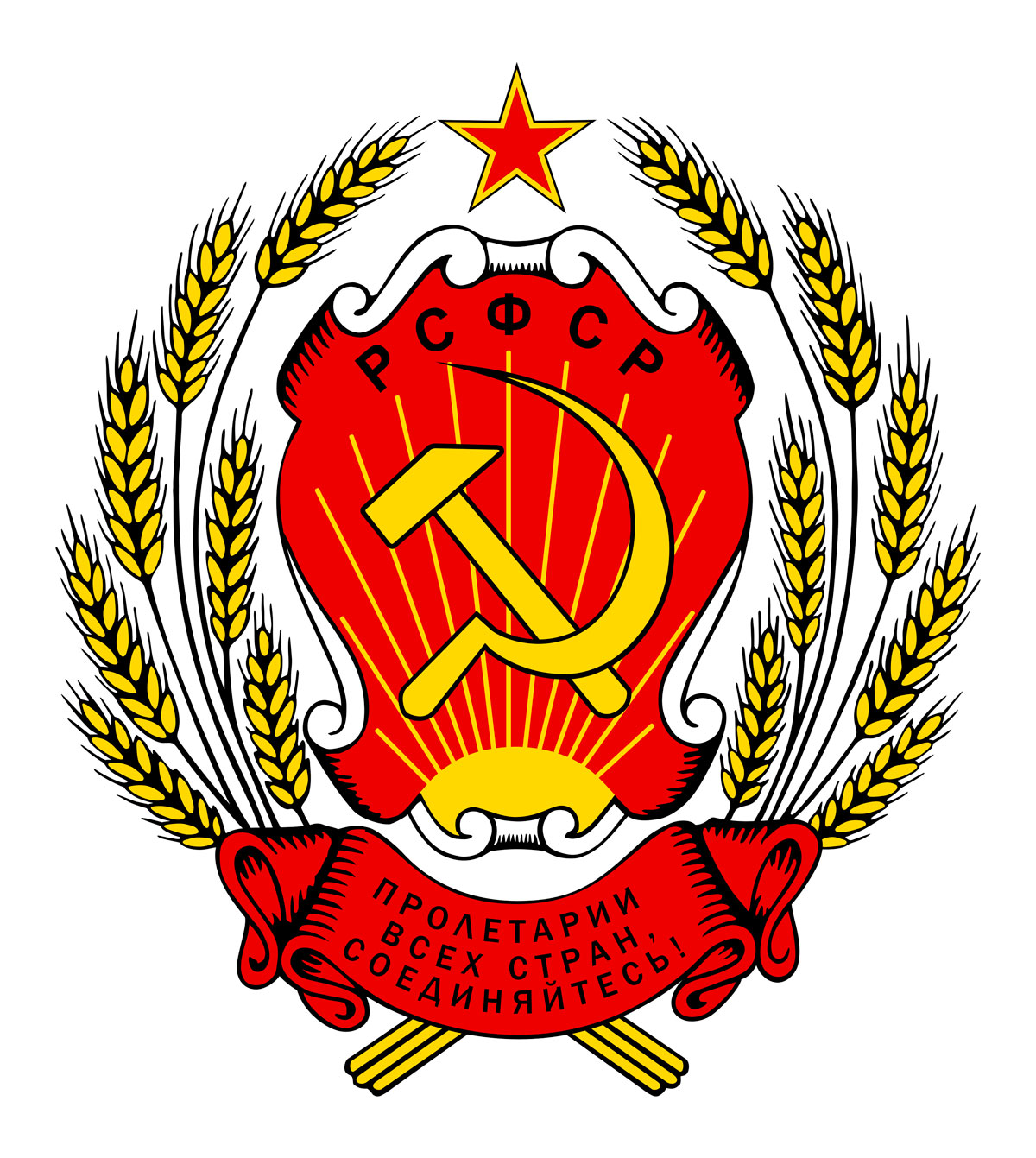
The State Emblem of the Russian Soviet Federative Socialist Republic is an image of a sickle and a hammer on a red background in the rays of the sun and framed by ears of corn with the inscription: "RSFSR" and "Proletarians of all countries, unite!" At the top of the emblem is a five-pointed star.
This is the central element of the Big Emblem of the Russian Empire (1882).
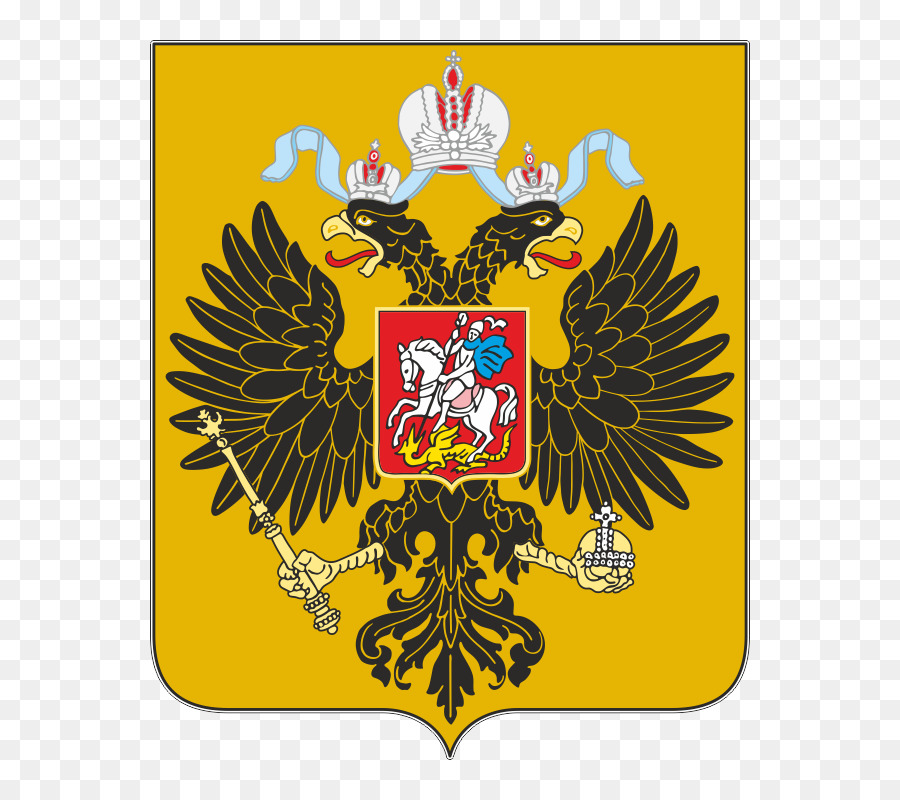
The Big Emblem of the Russian Empire (1882).
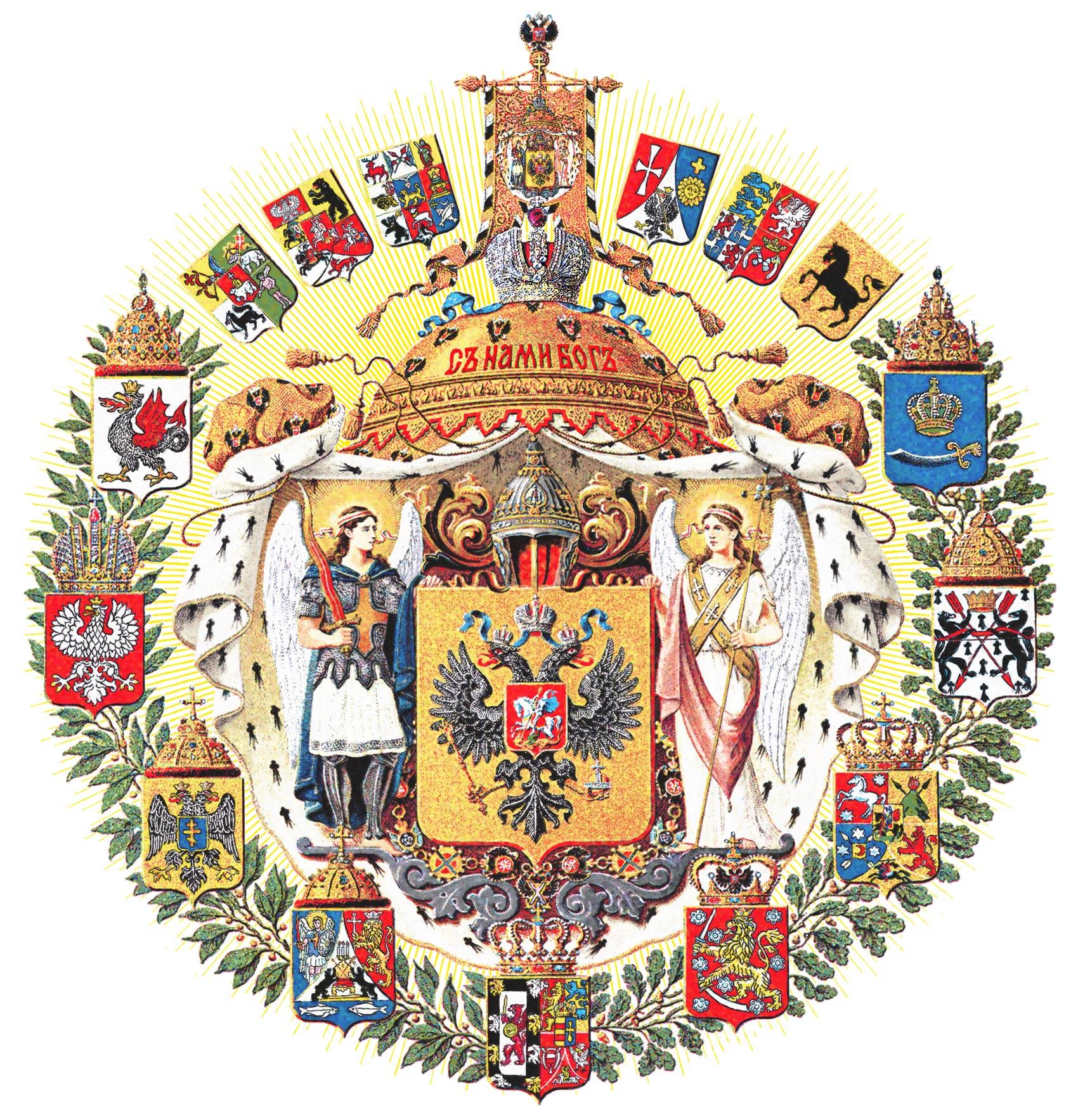
In the golden shield is a black double-headed eagle crowned with two imperial crowns, above which is the same, but larger crown, with two fluttering ends of the St. Andrew's Order ribbon. The state eagle holds a golden scepter and orb. On the chest of the eagle is the emblem of Moscow: inside a red shield with gold edges is the Holy Great Martyr and Victorious George, in silver armor and an azure mantle, on a silver horse (covered with a crimson cloth with gold fringe). He strikes a golden dragon (with green wings) with a golden spear, with an eight-pointed cross on top. Above the shield is the helmet of the Holy Grand Duke Alexander Nevsky. The background is black with gold. Around the shield is the chain of the order of St. Apostle Andrew the First-Called; on the sides of the shield are images of the holy Archangel Michael and the Archangel Gabriel. The canopy is golden, crowned with the imperial crown, with numerous Russian eagles and lined with ermine. On it is a red inscription: "God is with us!" Above the canopy is the state banner, with an eight-pointed cross on the shaft. The canvas of the state banner is golden; on it is an image of the middle state emblem, but without the surrounding nine shields.
The main shield is surrounded by nine shields from below:
1) Kazan kingdom;
2) Astrakhan kingdom;
3) Polish kingdom;
4) Siberian kingdom;
5) Chersonese Tauride kingdom [As far as I understand, this is Crimea and the regions adjacent to it];
6) Georgian kingdom;
7) Combined emblems of the great principalities: Kiev, Vladimir and Novgorod;
8) Grand Duchy of Finland;
9) Family emblem of His Imperial Majesty.
Six shields were placed above the canopy of the main shield:
1) Great Russia principalities and regions: Pskov, Smolensk, Tver, Yugra, Nizhny Novgorod, Ryazan, Rostov, Yaroslavl, Belozersk, Udora.
2) Southwestern principalities and regions: South-Western principalities and regions: Volyn, Podolia, Chernihiv.
3) Belarusian and Lithuanian principalities and regions: Lithuanian, Bialystok, Samogitian, Polotsk, Vitebsk, Mstislavl.
4) Baltic regions: Estonia, Livonia, Courland and Semigallia, Karelia.
5) Northeastern regions: Perm, Vyatka, Volga Bulgaria, Obdorsk, Kondinsk.
6) Turkestan [i.e. Kazakhstan, Kyrgyzstan, Tajikistan, Turkmenistan, Uzbekistan].
The Small Emblem of the Russian Empire (1882).
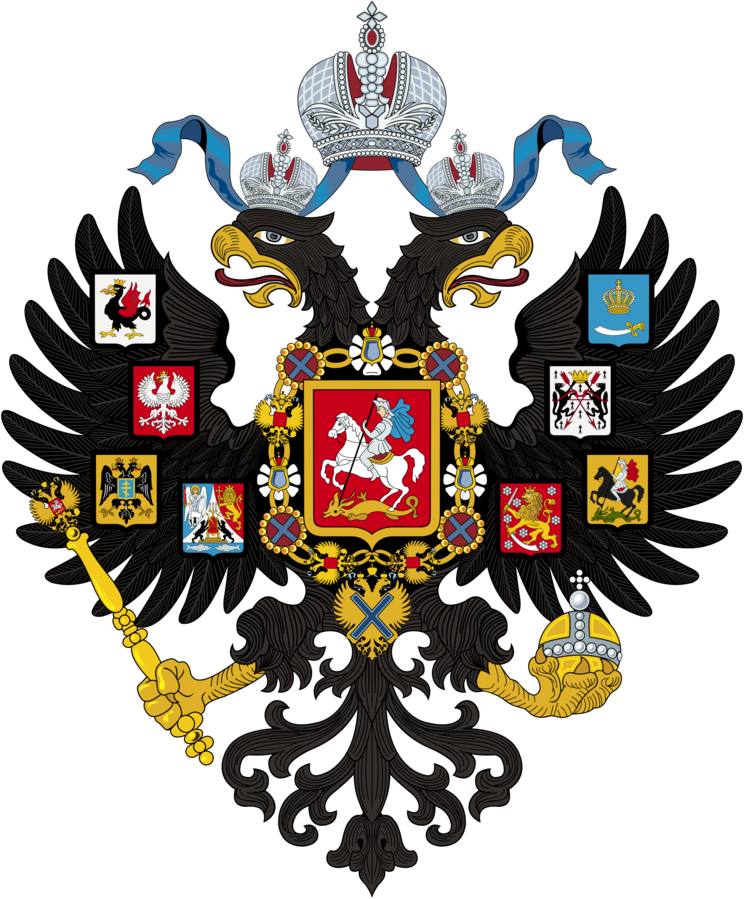

The Big Emblem of the Russian Empire (1882).

In the golden shield is a black double-headed eagle crowned with two imperial crowns, above which is the same, but larger crown, with two fluttering ends of the St. Andrew's Order ribbon. The state eagle holds a golden scepter and orb. On the chest of the eagle is the emblem of Moscow: inside a red shield with gold edges is the Holy Great Martyr and Victorious George, in silver armor and an azure mantle, on a silver horse (covered with a crimson cloth with gold fringe). He strikes a golden dragon (with green wings) with a golden spear, with an eight-pointed cross on top. Above the shield is the helmet of the Holy Grand Duke Alexander Nevsky. The background is black with gold. Around the shield is the chain of the order of St. Apostle Andrew the First-Called; on the sides of the shield are images of the holy Archangel Michael and the Archangel Gabriel. The canopy is golden, crowned with the imperial crown, with numerous Russian eagles and lined with ermine. On it is a red inscription: "God is with us!" Above the canopy is the state banner, with an eight-pointed cross on the shaft. The canvas of the state banner is golden; on it is an image of the middle state emblem, but without the surrounding nine shields.
The main shield is surrounded by nine shields from below:
1) Kazan kingdom;
2) Astrakhan kingdom;
3) Polish kingdom;
4) Siberian kingdom;
5) Chersonese Tauride kingdom [As far as I understand, this is Crimea and the regions adjacent to it];
6) Georgian kingdom;
7) Combined emblems of the great principalities: Kiev, Vladimir and Novgorod;
8) Grand Duchy of Finland;
9) Family emblem of His Imperial Majesty.
Six shields were placed above the canopy of the main shield:
1) Great Russia principalities and regions: Pskov, Smolensk, Tver, Yugra, Nizhny Novgorod, Ryazan, Rostov, Yaroslavl, Belozersk, Udora.
2) Southwestern principalities and regions: South-Western principalities and regions: Volyn, Podolia, Chernihiv.
3) Belarusian and Lithuanian principalities and regions: Lithuanian, Bialystok, Samogitian, Polotsk, Vitebsk, Mstislavl.
4) Baltic regions: Estonia, Livonia, Courland and Semigallia, Karelia.
5) Northeastern regions: Perm, Vyatka, Volga Bulgaria, Obdorsk, Kondinsk.
6) Turkestan [i.e. Kazakhstan, Kyrgyzstan, Tajikistan, Turkmenistan, Uzbekistan].
The Small Emblem of the Russian Empire (1882).

edit on 4 19 2022 by turretless because: (no reason given)
originally posted by: dollukka
I read that moscow was firstly inhabitated by Finno Ugric people not Russian.
All the Indo-European peoples of Europe are newcomers from other places.
At the time of the first written mention of Moscow (1147), the Slavs had long lived in these territories next to the Finno-Ugric peoples.
Emblem of Moscow.
(Moscow is one of the three cities of federal significance)
It is the main city of the Moscow region (and the whole country).
The official date of foundation of Moscow is the date of the first mention in the annals in 1147.
The title Hero City was received on May 8, 1965 with the award of the Gold Star medal and the Order of Lenin - for outstanding services to the Motherland, mass heroism, courage and stamina shown by the workers of the capital of the USSR, the city of Moscow, in the fight against the Nazi invaders, and in commemoration 20th anniversary of the victory of the Soviet people in the Great Patriotic War of 1941-1945.
The population of Moscow is 12,635,466 people (2022).
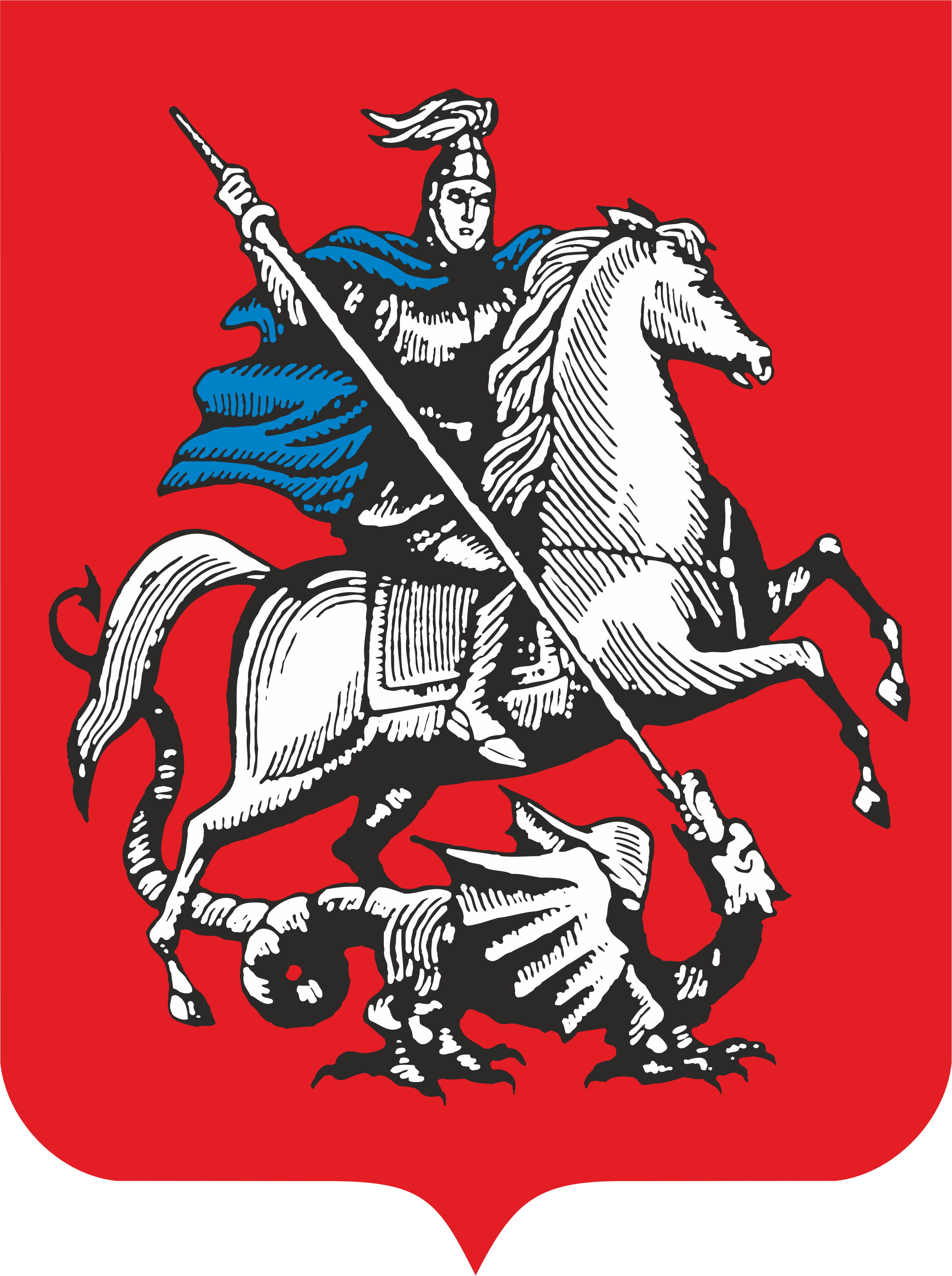
The emblem is a quadrangular with rounded lower corners and a dark red heraldic shield pointed at the tip. It depicts St. George the Victorious in silver armor and a blue mantle on a silver horse. The rider strikes a black dragon with a golden spear.
The image of a rider who fights a dragon gained particular popularity in Russia in the 14th-15th centuries and symbolized a fighter against foreign conquerors, as well as a people's defender. Saint George was the heavenly patron of the Moscow Prince Yuri Dolgoruky. From the time of Prince Dmitry Donskoy, the saint became the patron of the city of Moscow.
Soviet emblem of Moscow.
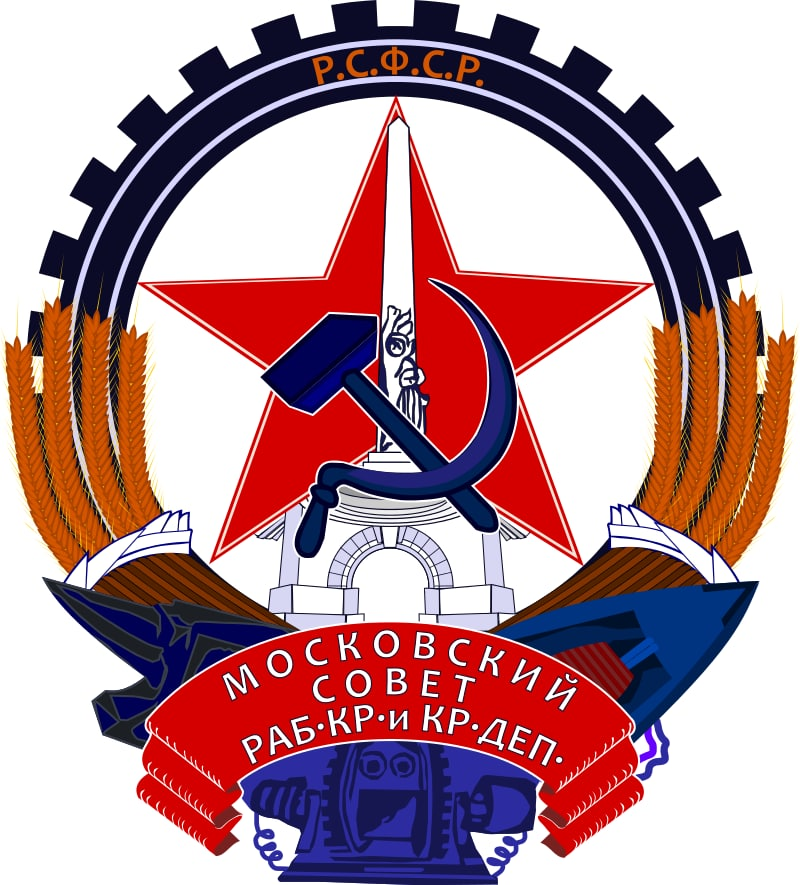
a) In the central part, a five-pointed star is inscribed in an oval shield. This is the victory symbol of the Red Army.
b) The obelisk against the background of a star, which is the first revolutionary monument of the RSFSR in memory of the October Revolution (placed in front of the Moscow City Council building). This is a symbol of the stability of Soviet power.
c) The hammer and sickle is the emblem of the workers' and peasants' government.
d) The cogwheel and the rye ears associated with it, depicted along the oval of the shield, are a symbol of the union of the town with the countryside, where the wheel with the inscription "RSFSR" represents industry, and the rye ears represent agriculture.
e) Below, on both sides, there are emblems characterizing the most developed industry in Moscow: the anvil is the emblem of the metalworking industry (on the left), the shuttle is the emblem of the textile industry (on the right).
f) Below, under the inscription (depicted on the ribbon) "Moscow Council [Sovet] of Workers, Peasants and Red Army Deputies", there is a "dynamo" representing electrification.
Emblem of Moscow in 1883.
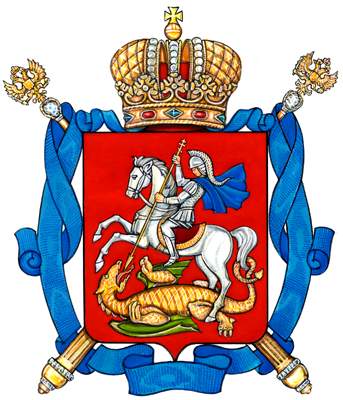
(Moscow is one of the three cities of federal significance)
It is the main city of the Moscow region (and the whole country).
The official date of foundation of Moscow is the date of the first mention in the annals in 1147.
The title Hero City was received on May 8, 1965 with the award of the Gold Star medal and the Order of Lenin - for outstanding services to the Motherland, mass heroism, courage and stamina shown by the workers of the capital of the USSR, the city of Moscow, in the fight against the Nazi invaders, and in commemoration 20th anniversary of the victory of the Soviet people in the Great Patriotic War of 1941-1945.
The population of Moscow is 12,635,466 people (2022).

The emblem is a quadrangular with rounded lower corners and a dark red heraldic shield pointed at the tip. It depicts St. George the Victorious in silver armor and a blue mantle on a silver horse. The rider strikes a black dragon with a golden spear.
The image of a rider who fights a dragon gained particular popularity in Russia in the 14th-15th centuries and symbolized a fighter against foreign conquerors, as well as a people's defender. Saint George was the heavenly patron of the Moscow Prince Yuri Dolgoruky. From the time of Prince Dmitry Donskoy, the saint became the patron of the city of Moscow.
Soviet emblem of Moscow.

a) In the central part, a five-pointed star is inscribed in an oval shield. This is the victory symbol of the Red Army.
b) The obelisk against the background of a star, which is the first revolutionary monument of the RSFSR in memory of the October Revolution (placed in front of the Moscow City Council building). This is a symbol of the stability of Soviet power.
c) The hammer and sickle is the emblem of the workers' and peasants' government.
d) The cogwheel and the rye ears associated with it, depicted along the oval of the shield, are a symbol of the union of the town with the countryside, where the wheel with the inscription "RSFSR" represents industry, and the rye ears represent agriculture.
e) Below, on both sides, there are emblems characterizing the most developed industry in Moscow: the anvil is the emblem of the metalworking industry (on the left), the shuttle is the emblem of the textile industry (on the right).
f) Below, under the inscription (depicted on the ribbon) "Moscow Council [Sovet] of Workers, Peasants and Red Army Deputies", there is a "dynamo" representing electrification.
Emblem of Moscow in 1883.

edit on 4 19 2022 by turretless because: (no reason given)
a reply to: turretless
Is this like a modernized version of the Nazi's prattling on about their "Aryan" heritage?
I mean, it's nice cultural travellogue information, but what relevance does it have to the rest of the planet, and specifically to ATS?
I get it that you have a pride in your community, but in this current situation there is a tyrannical dictator attacking a nearby independent state and also making overt threats against other countries. He has assassinated his own countrymen who are politically his opponents, and is arresting citizens who question his methods.
I don't blame the Russian people for the actions of its dictator.
All the Russians I know are great people, with an excellent sense of humor, and are rightly proud of their culture.
Is this like a modernized version of the Nazi's prattling on about their "Aryan" heritage?
I mean, it's nice cultural travellogue information, but what relevance does it have to the rest of the planet, and specifically to ATS?
I get it that you have a pride in your community, but in this current situation there is a tyrannical dictator attacking a nearby independent state and also making overt threats against other countries. He has assassinated his own countrymen who are politically his opponents, and is arresting citizens who question his methods.
I don't blame the Russian people for the actions of its dictator.
All the Russians I know are great people, with an excellent sense of humor, and are rightly proud of their culture.
Super interesting! I love hearing about other places and hope that members can restrain themselves from trying to derail because it's about russia.
What do you make of the Tataria/Tartaria conspiracy considering the old maps locate it in russia?
What do you make of the Tataria/Tartaria conspiracy considering the old maps locate it in russia?
originally posted by: igloo
Super interesting! I love hearing about other places and hope that members can restrain themselves from trying to derail because it's about russia.
What do you make of the Tataria/Tartaria conspiracy considering the old maps locate it in russia?
These maps were made in the pre-scientific era.
Europeans made them based on the stories of travelers. Apparently, often these travelers simply recounted the stories of other people. For example, Plano Carpini talked about cynocephali (a dog-headed tribe) and people with one arm and one leg instead of a body, and so on.
How many Europeans do you know who visited those areas of the world that are called Tartaria on their maps?
In other words, Tartaria appeared on the maps as a result of European ignorance (or they had a poor idea of what exactly was included in the empire of Genghis Khan).
Here is a short article about this by the Russian Geographical Society (in Russian) - www.rgo.ru...
Small emblem of St. Petersburg.
(St. Petersburg is another city of federal significance)
It is the main city of the Leningrad region.
It was founded in 1703 by Tsar Peter the Great. From 1712 to 1918 St. Petersburg was the capital of the Russian Empire.
The population of St. Petersburg is 5,377,503 people (2022).
The title of Hero City was awarded on May 1, 1945 by order No. 20 dated May 1, 1945. The Gold Star medal was awarded on May 8, 1965 "for outstanding services to the Motherland, courage and heroism shown by the working people of Leningrad in the fight against the Nazi invaders in the difficult conditions of a long enemy blockade, and in commemoration of the 20th anniversary of the victory of the Soviet people in the Great Patriotic War of 1941-1945."
The city changed its name several times. St. Petersburg (Санкт-Петербург) - 1703-1914; Petrograd (Петроград) - 1914-1924; Leningrad (Ленинград) - 1924-1991; St. Petersburg 1991-
(It was renamed Petrograd because then there was a war with Germany and it was ideologically wrong to call the capital in the German manner, so the city was renamed in the Russian manner.)
The city was built at the mouth of the Neva River and on the shores of the Gulf of Finland.
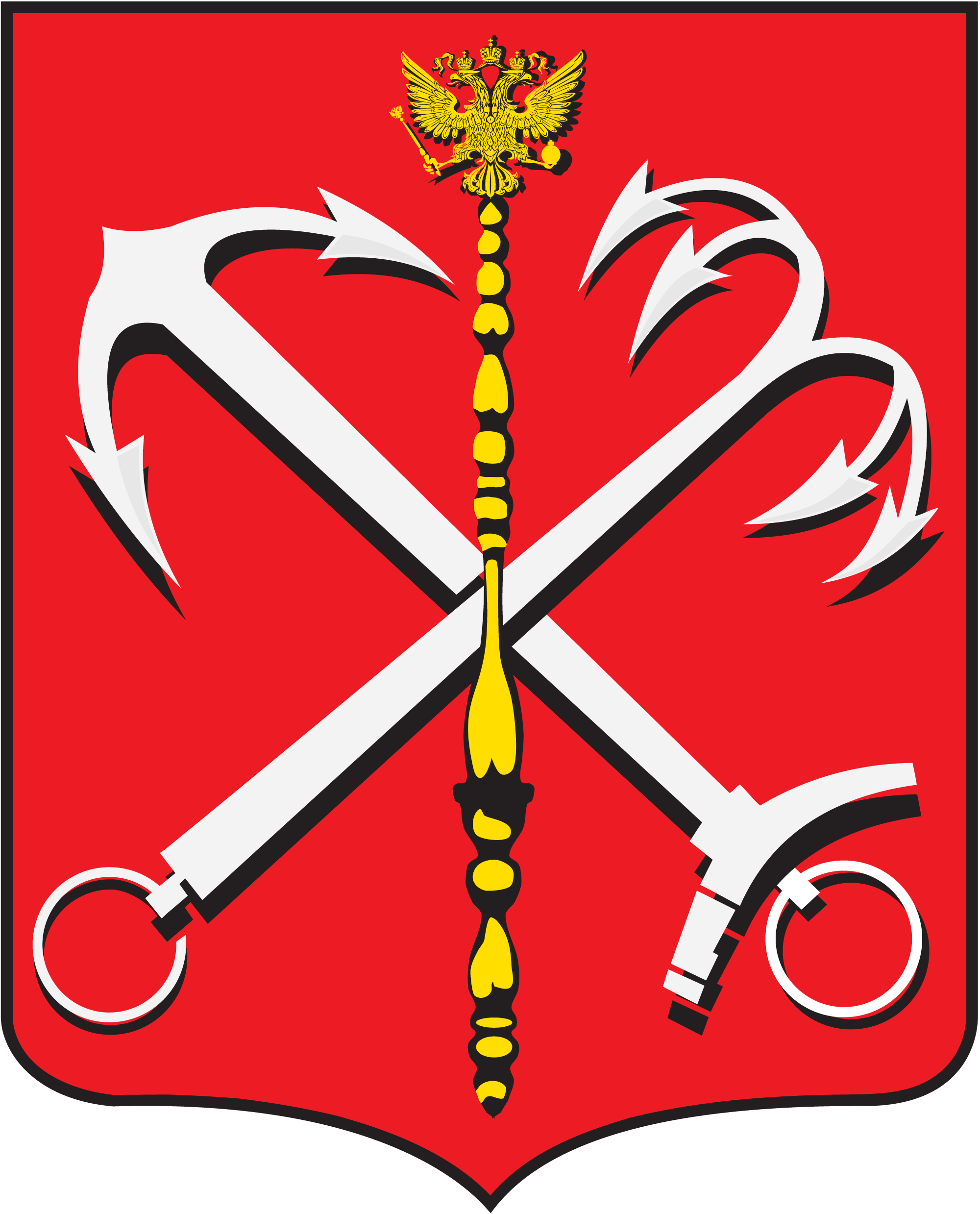
Big emblem of St. Petersburg.
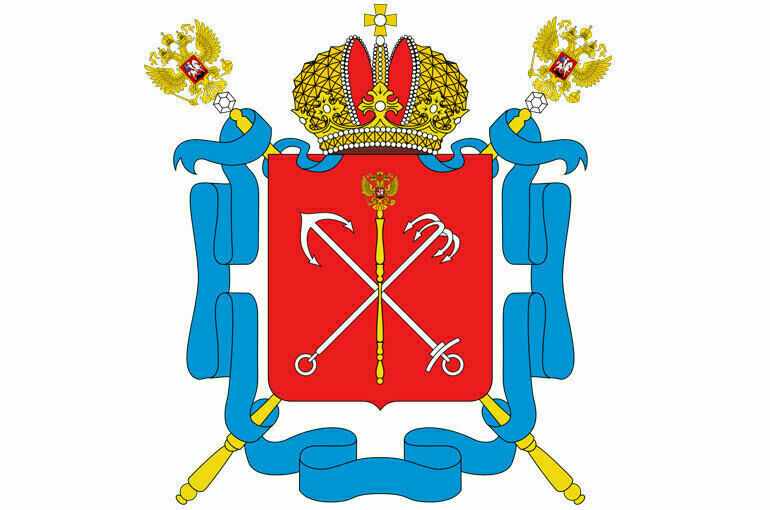
A heraldic red shield with an image of two silver anchors placed crosswise against its background: 1) a sea anchor (obliquely from the left to the right of the viewer, with paws in the upper left corner of the shield from the viewer; it has two paws and a transverse detail on the anchor rod) and 2) a river anchor (obliquely from right to left of the viewer, paws in the upper right corner of the shield from the viewer; has four paws and is devoid of a transverse detail on the anchor rod). A golden scepter with a double-headed eagle is laid on the anchors. The shield is crowned with an imperial crown with two St. Andrew's azure ribbons emerging from it. Behind the shield are two crossed golden Russian scepters, decorated with diamonds and enamel, connected by an Andreev azure ribbon.
Soviet emblem of Leningrad.
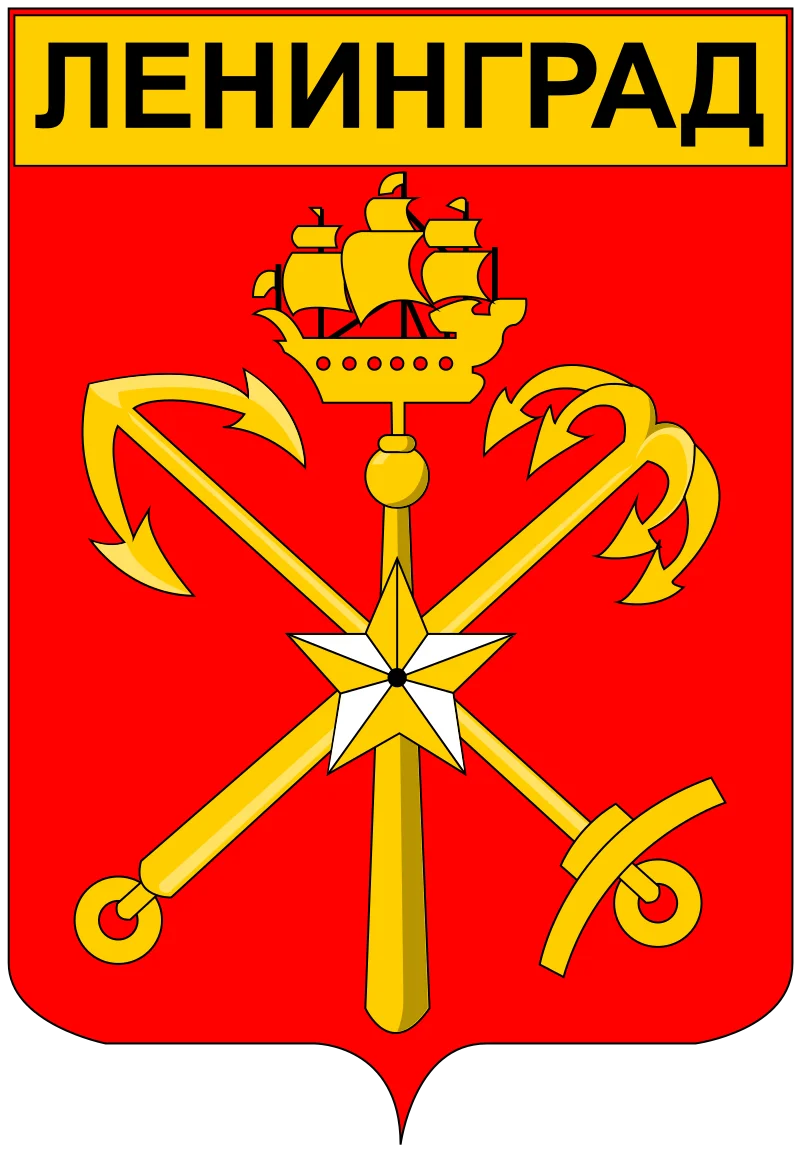
Emblem of St. Petersburg during the Russian Empire.
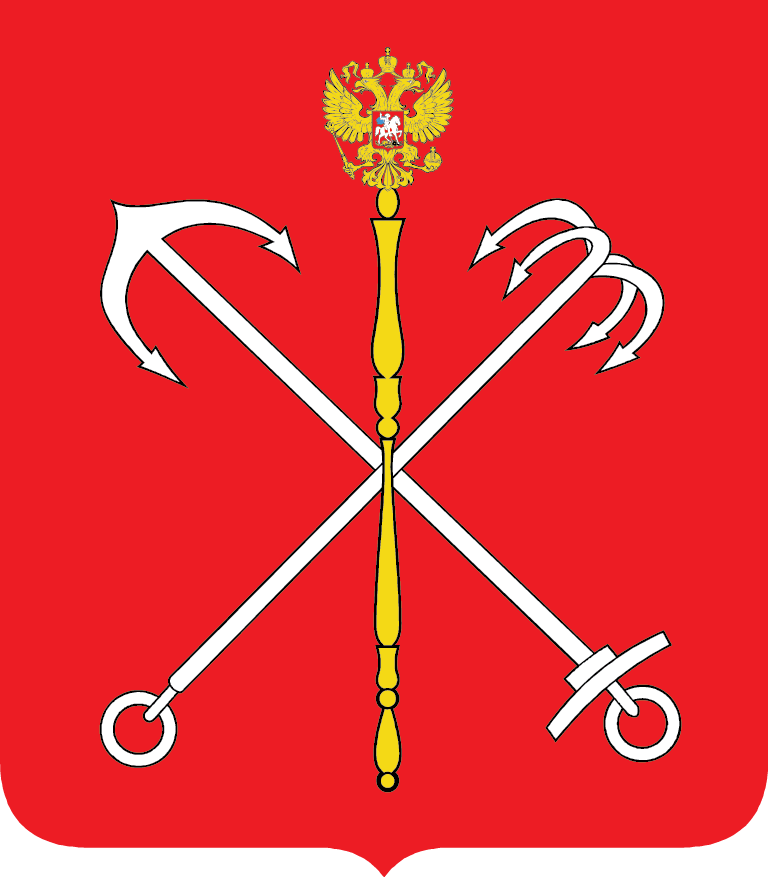
(St. Petersburg is another city of federal significance)
It is the main city of the Leningrad region.
It was founded in 1703 by Tsar Peter the Great. From 1712 to 1918 St. Petersburg was the capital of the Russian Empire.
The population of St. Petersburg is 5,377,503 people (2022).
The title of Hero City was awarded on May 1, 1945 by order No. 20 dated May 1, 1945. The Gold Star medal was awarded on May 8, 1965 "for outstanding services to the Motherland, courage and heroism shown by the working people of Leningrad in the fight against the Nazi invaders in the difficult conditions of a long enemy blockade, and in commemoration of the 20th anniversary of the victory of the Soviet people in the Great Patriotic War of 1941-1945."
The city changed its name several times. St. Petersburg (Санкт-Петербург) - 1703-1914; Petrograd (Петроград) - 1914-1924; Leningrad (Ленинград) - 1924-1991; St. Petersburg 1991-
(It was renamed Petrograd because then there was a war with Germany and it was ideologically wrong to call the capital in the German manner, so the city was renamed in the Russian manner.)
The city was built at the mouth of the Neva River and on the shores of the Gulf of Finland.

Big emblem of St. Petersburg.

A heraldic red shield with an image of two silver anchors placed crosswise against its background: 1) a sea anchor (obliquely from the left to the right of the viewer, with paws in the upper left corner of the shield from the viewer; it has two paws and a transverse detail on the anchor rod) and 2) a river anchor (obliquely from right to left of the viewer, paws in the upper right corner of the shield from the viewer; has four paws and is devoid of a transverse detail on the anchor rod). A golden scepter with a double-headed eagle is laid on the anchors. The shield is crowned with an imperial crown with two St. Andrew's azure ribbons emerging from it. Behind the shield are two crossed golden Russian scepters, decorated with diamonds and enamel, connected by an Andreev azure ribbon.
Soviet emblem of Leningrad.

Emblem of St. Petersburg during the Russian Empire.

It seems that this post will end the topic.
Because Kaspersky Anti-Virus, when I try to enter the "Upload" tab, says that the certificate has expired.
After I overcome the resistance of the antivirus and download the pictures, I cannot see them.
Apparently there is a limit on the forum about uploading pictures or something else that I don't understand.
Because Kaspersky Anti-Virus, when I try to enter the "Upload" tab, says that the certificate has expired.
After I overcome the resistance of the antivirus and download the pictures, I cannot see them.
Apparently there is a limit on the forum about uploading pictures or something else that I don't understand.
Interesting thread, thank you. I was involved in heraldry engraving signet rings and became fascinated with the subject. Few realize the importance of
every element and even color. Russia has a very long and complex history, thus the animosities stirred up over the Ukraine are heavily influenced by
neighboring states once part of the Soviet Union and Russia before that; Poland, Lithuania, Estonia and Latvia in particular. It was fighting with
Poland and Sweden (who once ruled Finland) that determined much of the Western boundaries which remain in dispute today. If people knew their history
a little better they would understand nothing is cut and dry and that centuries of dispute are still remembered by those who live there. Most people
think Russia "stole" Crimea not knowing that Russia conquered it from the Crimean Khanate hundreds of years ago and it remained a part of Russia
proper until Kruschev delegated as part of the Ukrainian political district since Kruschev was Ukrainian and I believe wanted the prestige of Crimea,
Sevastopol and the Black Sea fleet attached to Ukraine. My own pet theory anyway.
Pop quiz: what countries invaded the Crimea in 1854 and why?
The west has a long history of meddling in Russian affairs.
Pop quiz: what countries invaded the Crimea in 1854 and why?
The west has a long history of meddling in Russian affairs.
a reply to: Asktheanimals
Thank you!
I wanted to continue the topic with the third federal city of Sevastopol.
But I had difficulties and I don’t know how to overcome them (I wrote about this in a previous post).
Thank you!
I wanted to continue the topic with the third federal city of Sevastopol.
But I had difficulties and I don’t know how to overcome them (I wrote about this in a previous post).
a reply to: turretless
I had several guesses what your third city would be, I just got lucky.
Kiev, Stalingrad(Volvograd) and Odessa all came to mind as well.
What did you think of my theory about Kruschev?
I have yet to hear anyone explain why he would want to move it to a different district politically.
Are political areas called Oblasts btw?
I had several guesses what your third city would be, I just got lucky.
Kiev, Stalingrad(Volvograd) and Odessa all came to mind as well.
What did you think of my theory about Kruschev?
I have yet to hear anyone explain why he would want to move it to a different district politically.
Are political areas called Oblasts btw?
new topics
-
Any one suspicious of fever promotions events, card only.
The Gray Area: 14 minutes ago -
God's Righteousness is Greater than Our Wrath
Religion, Faith, And Theology: 4 hours ago -
Electrical tricks for saving money
Education and Media: 7 hours ago -
VP's Secret Service agent brawls with other agents at Andrews
Mainstream News: 9 hours ago -
Sunak spinning the sickness figures
Other Current Events: 9 hours ago -
Nearly 70% Of Americans Want Talks To End War In Ukraine
Political Issues: 10 hours ago -
Late Night with the Devil - a really good unusual modern horror film.
Movies: 11 hours ago
top topics
-
VP's Secret Service agent brawls with other agents at Andrews
Mainstream News: 9 hours ago, 9 flags -
Cats Used as Live Bait to Train Ferocious Pitbulls in Illegal NYC Dogfighting
Social Issues and Civil Unrest: 13 hours ago, 8 flags -
Electrical tricks for saving money
Education and Media: 7 hours ago, 4 flags -
HORRIBLE !! Russian Soldier Drinking Own Urine To Survive In Battle
World War Three: 17 hours ago, 3 flags -
Sunak spinning the sickness figures
Other Current Events: 9 hours ago, 3 flags -
Nearly 70% Of Americans Want Talks To End War In Ukraine
Political Issues: 10 hours ago, 3 flags -
Late Night with the Devil - a really good unusual modern horror film.
Movies: 11 hours ago, 2 flags -
The Good News According to Jesus - Episode 1
Religion, Faith, And Theology: 15 hours ago, 1 flags -
Any one suspicious of fever promotions events, card only.
The Gray Area: 14 minutes ago, 1 flags -
God's Righteousness is Greater than Our Wrath
Religion, Faith, And Theology: 4 hours ago, 0 flags
active topics
-
SETI chief says US has no evidence for alien technology. 'And we never have'
Aliens and UFOs • 50 • : andy06shake -
Any one suspicious of fever promotions events, card only.
The Gray Area • 0 • : Cavemannick -
God's Righteousness is Greater than Our Wrath
Religion, Faith, And Theology • 1 • : andy06shake -
Sunak spinning the sickness figures
Other Current Events • 7 • : xWorldxGonexMadx -
HORRIBLE !! Russian Soldier Drinking Own Urine To Survive In Battle
World War Three • 33 • : Degradation33 -
How ageing is" immune deficiency"
Medical Issues & Conspiracies • 34 • : angelchemuel -
Nearly 70% Of Americans Want Talks To End War In Ukraine
Political Issues • 13 • : Freeborn -
Mood Music Part VI
Music • 3101 • : ThatSmellsStrange -
VP's Secret Service agent brawls with other agents at Andrews
Mainstream News • 41 • : ThatSmellsStrange -
New whistleblower Jason Sands speaks on Twitter Spaces last night.
Aliens and UFOs • 55 • : baablacksheep1
